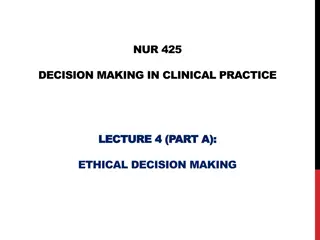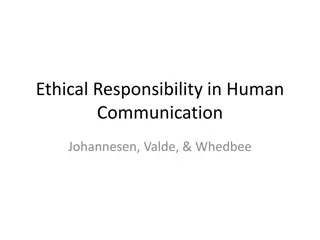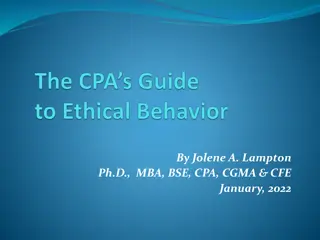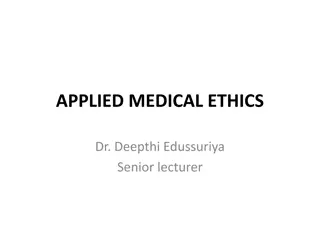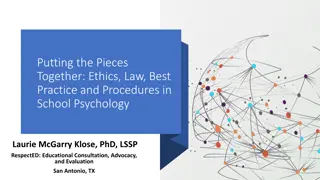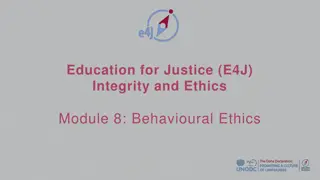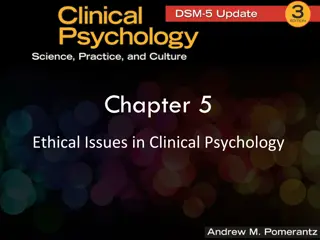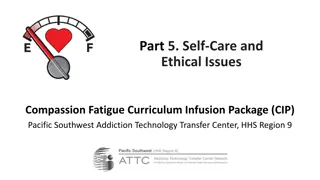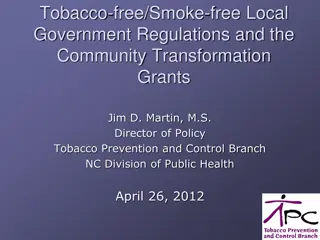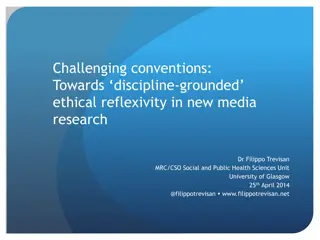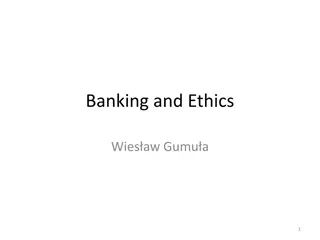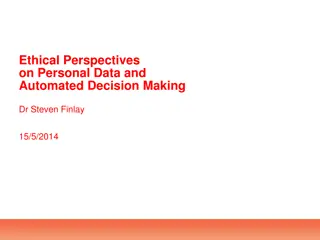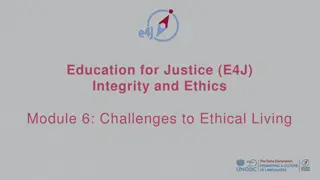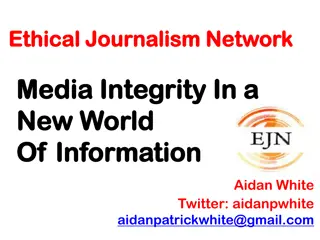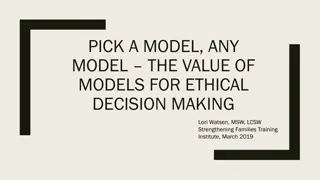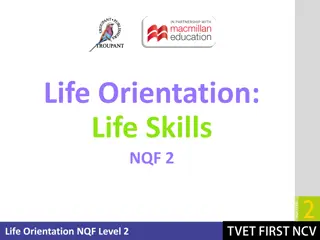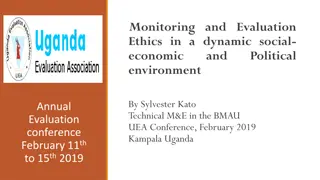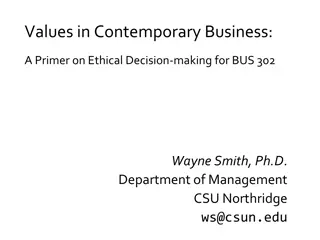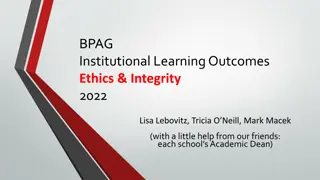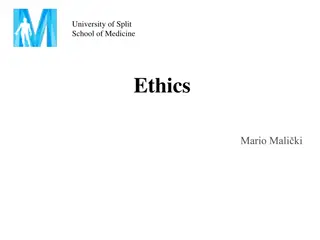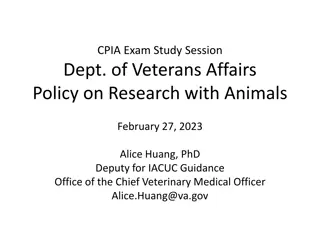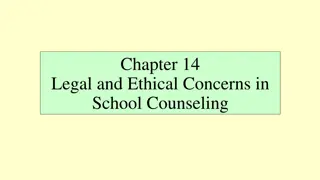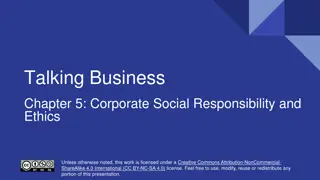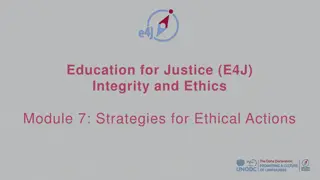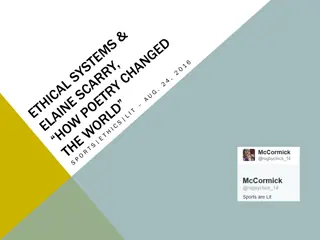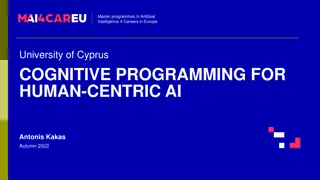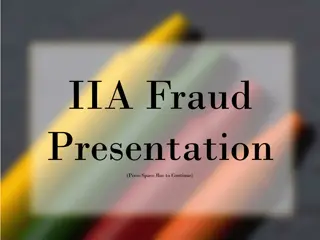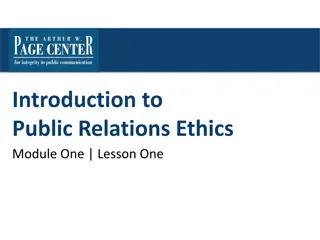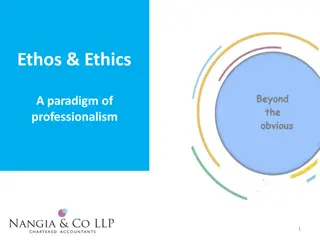Ethical Challenges in Megabanking and Government Regulations
Talk delves into the diminishing ethical standards in megabanking and regulatory cultures, citing the Dunning-Kruger Effect. Analysis focuses on the prevalence of unethical behaviors leading to financial crises, emphasizing solutions found closer in the UK. The model of executive cultures and the Dunning-Kruger Effect are used to illustrate the persistence of malignant cultures in the financial sector.
Download Presentation

Please find below an Image/Link to download the presentation.
The content on the website is provided AS IS for your information and personal use only. It may not be sold, licensed, or shared on other websites without obtaining consent from the author. Download presentation by click this link. If you encounter any issues during the download, it is possible that the publisher has removed the file from their server.
E N D
Presentation Transcript
International Workshop on Financial System Architecture & Stability Montreal, Canada August 24, 2017 ETHICS VERSUS ETHOS IN US AND UK MEGABANKING Edward J. Kane Boston College 1
SUMMARY My talk is built around the idea that the cultures of megabankers and (especially) prudential regulators have lost sight of ethical principles and do not fully appreciate it: The Dunning-Kruger Effect. My explanation for the growing severity of periodic financial crises focuses on norms in megabanking and government executive cultures that squeeze out moral concepts of right and wrong and support waves of criminal taxpayer abuse that amounts to a form of theft by safety net. Path to a solution for this is closer in UK than in US. My analysis employs the predominant model of executive culture developed by Schein in the field of cultural anthropology, in contrast to the business organization models that other economists use. I use cartoons to illustrate how a joint culture of loss concealment and disinformation feeds and intensifies financial crises. 2
MALIGNANT CULTURES PERSIST BECAUSE OF THE DUNNING-KRUGER EFFECT D-K hypothesized and (with others) have confirmed that, for a given skill, poorly performing persons will fail to recognize their own lack of skill, fail to recognize the extent of their inadequacy, and fail to recognize genuine skill in others. Top regulators and megabankers show many skills, but they over-rate their personal and corporate ethical standards, which are shaped by the predatory culture of modern finance and overly forgiving standards of judicial and administrative reviews. 3
WHY WE CAN MODEL SOMETHING AS SQUISHY AS CULTURE A model is a deliberately simplified logical system that defines a set of variables and analyzes their interaction. Does not have to be Math-driven. Conceptual distinctions underlie the definitions of variables. In evaluating policy, the more insightful the model s distinctions, the more useful the model. 4
Scheins Model of a Corporations or Agency s Character or Culture Edgar Schein s model of organizational culture is a model of constrained maximization with three distinct components: 1. espoused goals and strategies for achieving them; 2. artifacts: processes the organization uses and other observable features of its operation; and 3. deeply imbedded behavioral norms and shared assumptions ( beliefs ) about how to behave in different circumstances. These unspoken and resilient norms and assumptions (les non-dits) often conflict with espoused goals. 5
EXECUTIVE CULTURES OF PROFIT MAXIMIZATION (at banks) AND BLAME AVOIDANCE (in government) INTERACT WITH LITTLE ROLE FOR MORALITY PER SE Realistically, Megabank executives wrestle every day with three issues: 1. What is profitable for our firm to do? 2. What will the culture-driven supervisory activity of our regulators let us get away with*? 3. How can we defend and expand these profit- making opportunities? *Legality is as close to right and wrong as executive cultures get. This is what makes regulatory culture so critical. 6
Central Bank Self-Image : Central bankers see themselves as a noble and unfairly scapegoated team of heroes who in tough times are assigned overambitious goals by cynical politicians. [ Organization and management is inherently hierarchical, with great power distances as we move away from the agency head. Carefully phrased dissent may be expressed from time to time, but there is little tolerance of outright disagreement: leads to GROUPTHINK Short time horizon: Central banks perennially focus on achieving demonstrable short-term results. Are attracted to policies that they know can have bad long-term effects. ] 7
Cultural Norms are resilient because they are communicated by seeing what behaviors lead to advancement. Rising in any hierarchy depends on an ability to perceive and conform to a series of behavioral norms drilled into newbies. My paper identifies 6 behavioral norms for central bankers: 1. Industry-Centered norms of partiality, clientele service, and feeble correction of supervisory shortfalls to protect clients earning power. 2. Mercy and benefit-of-the-doubt norms that dictate sympathy, help, and lenient discipline for distressed client firms and their creditors at virtually all times. 3. Loss-concealment norms that due to an ingrained fear of runs and meltdowns-- demand that regulators must not only hold adverse client information confidential, but misrepresent this information when this is thought to promote the short-term common good. 4. Reluctance to Prosecute High-Ranking Bankers for Reckless Behavior [5. Performance standards that honor employees for not rocking the boat 6. Blame-avoidance norms that urge staff members to protect the professional reputations of team leaders by not admitting agency mistakes even to themselves.] 8
Performance norms for Crisis management illustrate long-held assumptions about how regulators in advanced countries prefer to deal with megabank distress ( Bagehot Protocol): A Market-Calmingnorm that says it is okay tomischaracterize the character of a zombie firm s distress as a liquidity problem to prevent or stop a threatened run or meltdown, and A Preference for completely rescuing the creditors of institutions that are difficult to unwind or sell off. My working hypothesis is that these 2 norms undermine stability, but this elitist rescue mentality is part of the nonpublic character of central-bank regulatory cultures around the world. No matter how much either the weapons of prudential regulation are enhanced after a crisis or bail-in powers expanded, until these anti- egalitarian norms are confronted and modified, megabanks and their creditors will foster weaknesses in transparency and data quality (e.g., in handling correlations in risk aggregation) that let them play successive games of hide-and-seek with regulators during booms and chicken in the following bust. [It is irrational to reinforce behavior without expecting to see it again and dangerous to presume that next time will be different.] 9
SAFETY NET SUBSIDIES COME FROM CULTURE-DRIVEN FORBEARANCE From Minimal-haircut policies of insolvency resolution incentivize tail risk and coerce unlimited implicit guarantees from taxpayers for mega-institutions because: 1) In crises, the souring of megabank tail risks push central banks into unwinnable games of chicken. 2) Why Regulators chicken out: (1) they fear stigma of having an industry meltdown on their watch, (2) giant firms are economically, politically, and administratively difficult to unwind, and (3)they don t want to slam any revolving doors or shut off speaking fees. [Regulators justify Implicit guarantees to themselves by claiming a duty of rescue, but Kant makes it clear that this duty is imperfect and inferior to a perfect duty (i.e., a moral imperative) of not harming other citizens. Do burly passengers have the right to push 50 weaker refugees off an overloaded boat? Creditors of giant firms expect to be paid off without haircuts come hell or high water and this unshakable belief generates export subsidies for mega- firms from financial-center countries like the US and UK.] 10
THE SAFETY NET IS A CRIMINALIZABLE RACKET To Rebalance Incentives in Government and Industry, Legislatures Should Re-characterize Artful Exploitation of the Safety Net Not as inevitable moral hazard, but as an Outlawable Form of Theft or Reckless Endangerment. TBTF or SIFI Firm s Funding Structure Contains A Coercive Taxpayer Put (a Coco) from Expected Crisis- Management Policy that Makes Taxpayers Into De Facto Minority Equity Investors. 11
PART OF THE DECEPTION IS TO CALL BAILOUTS LOANS AND INSURANCE PAYMENTS RATHER THAN LOSS-ABSORBING EQUITY FUNDING TAXPAYERS EQUITY POSITION IS INFERIOR TO THAT OF ORDINARY SHAREHOLDERS IN 5 WAYS: Taxpayers cannot trade their Positions Away. Downside liability is not contractually limited, but upside gain is. Taxpayer Positions are poorly compensated and carry no Procedural or Disclosure Safeguards. Taxpayer positions are not recognized legally as an equitable interest. This allows firms that are difficult to fail and difficult to unwind (DFDU) to exploit taxpayers without fear of lawsuits. Managers can and do abuse taxpayers by Blocking or Delaying Recovery and Resolution.
POLICY RECOMMENDATIONS Fairness is the Stated Goal of all Law. I employ Kant s common-sense concept of fairness to establish that megabanks & central banks abuse taxpayers. Taxpayers are used as coerced suppliers of loss-absorbing equity funding for TBTF firms. Governments have a duty to acknowledge that and to make company law explicitly recognize and protect taxpayer interests in crisis-prevention and crisis-management policies. Tail risk like speed is measurable, albeit imperfectly. The reckless pursuit of tail risk by megabankers resembles reckless driving. The harm this business model visits on the citizenry implies the need for laws fiduciary law by which to change incentives by identifying and penalizing extreme recklessness and prosecuting: (1) managers who knew or should have knownthey were pursuing this kind of abuse (e.g., fraudulent or wrongful trading in the UK) and (2)regulators who willfully tolerate this behavior. To create a reasonable burden of proof and an obligation to prosecute, the new laws should include presumptive tests for megabank recklessness that parallel those we see in laws that punish reckless driving and driving under the influence. The structure of individual punishments should parallel those used in enforcing traffic laws: a point and fine system that reflects the severity of particular violations, penalizes repeat violators, and, in extreme cases, could pass the case on to the criminal courts. 13
Major Takeaways 1. Recognizing taxpayers implicit equity stake implies that individual politicians, regulators, directors, and senior management owe: (1) de facto fiduciary duties toward taxpayers and (2) a fair dividendon the value of taxpayers stake. 2. Violating these fiduciary duties entails an abuse of trust that today is overly hard- to- prove ( e.g., promoting deceptive accounting so as to permit rampaging zombies to exist). Resulting Wealth transfers are thefts that deserve to be made easily punishable by civil and even criminal penalties(i.e., by fiduciary law). 3. The artifacts of a culture may change quickly, but the norms of a culture resist change fiercely. 4. To transform a predatory culture into a prudential culture requires institutionalizing individual and prosecutorial not corporate-- accountability and responsibility both at the bank and central-bank levels. This begins with setting up systems to measure, test, price, and respond to changes in the value of megabank subsidies as financial arrangements evolve through time. 5. Corporate-level fines do not challenge the anti-egalitarian norms that sustain the abuse. But prosecuting and even jailing bad-apple executives and regulators could create the kind of shock that cultural research says is necessary to challenge longstanding norms and replace them with values that can better align incentives with ethics in the financial services industry. 14
The Laddered Stock Options CEOs and Risk- Management Officers Ought to Face After Recklessly Leading a Megabank into Insolvency 15
UK Law Has Made a Good, but Hesitant Start For corporations generally, The Insolvency Act of 1986 defines crimes called insolvent trading and wrongful trading. Directors who know or should have known their zombie firm is insolvent and add to the debts of their company anyway can be made personally liable for company debts and disqualified from serving as a director of other UK corporations for a number of years. The purpose of the law is to encourage directors to enter into a creditor-liquidator agreements that prioritize the interests of the creditors and the creditors guarantors. The Financial Services (Banking Reform) Act of 2013 created a new criminal offense of reckless misconduct leading to the insolvency of a bank and a burden of proof that would have required senior bankers to prove that they took every reasonable step to prevent regulatory breaches in their areas of responsibility. Guilty parties were to be subject to unlimited fines and up to 7 years in prison. 16
Lobbying and Regulatory Culture Resist Attempts to Establish Easy-to-Prove Burdens The toughened burden of proofthat the UK s December 2013 law sought to establish was scheduled to apply to banking firms beginning in March, 2016. My cat-and-mouse model of regulatory and bank cultures predicts that regulators would prefer not to enforce anything like the letter of this law. Indeed, on Oct. 18, 2015, the newly elected Conservative government introduced a statutory duty of responsibility for all financial-services firms designed to supersedeboth the law s burden of proof and its sharp focus on acts that lead to insolvency. The new burden of proof turns on a general requirement for authorities to show that an individual failed to take steps that were reasonable for a person in his position to take to prevent a rules-oriented regulatory breach (as opposed to a harm-basedinsolvency). 17


